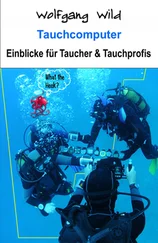• As said, the controlling tissue of the RDP is the 60-minute compartment, while for the original US Navy tables it’s the 120-minute compartment. For military divers with their given dive objectives and profiles a 120-minute compartment may be quite adequate, for recreational diving it is unnecessary conservative. The calculated (still safe) saturation level of this controlling tissue is further used for planning the maximum safe dive time for a repetitive dive which divers know to have shorter no-decompression times than the previous dive. Just so much at this point on that topic, later in this eBook a bit more. One additional hint regarding the number of compartments which are used in the algorithm of the RDP. For planning dives on sea level and to a maximum altitude of 300 meters/1.000 feet the RDP is based on above presented 14 compartments; for altitudes above 300 meters/1.000 feet as many as 20 compartments were used to calculate the RDP altitude conversion. (See Richardson, Drew, Deep, Repetitive Diving – A New Rule Applies, The Undersea Journal, Third Quarter 1989, p. 26)
• Following the RDP “Wheel” and RDP table launch in 1988, further dive tables were introduced for using the RDP not only with air but also with Enriched Air / Nitrox: the EANx32 and EANx36 RDPs, released in 1996; and years later also “electronic” dive tables followed: the eRDP (2005) und the eRDPML (2008). The eRDPML uses the validated data of the RDP in its original “Wheel“ version, so that even multilevel dives for up to three levels can be calculated as no-stop dives. [Note: This dive planner is no dive computer and can not be taken under water.]

Reflections on a proper ascent rate
The Recreational Dive Planner (RDP) has been tested and validated for a maximum ascent rate of 18 meters/60 feet per minute; for diving at higher altitudes, which means for the RDP beyond 300 meters/1.000 feet above sea level, the ascent rate is limited to 9 meters/30 feet per minute. Other dive tables and present-day dive computers usually stipulate 10 meters/33 feet per minute or even slower; other dive computers also use varying ascent rates for different depth ranges.
Note: The US Navy dive tables also prescribed a maximum ascent rate of 60 ft/min until 1993; since then 30 ft/min is the official US Navy limit – „with no change made in any of the table entries“.
Source: NEDU - US Navy Experimental Diving Unit, Graphical Analysis: Decompression Tables and Dive-Outcome Data; Panama City, Florida (USA) 2004, p. 2; download link see bibliography
What is known about the background of the ascent rate?
During a workshop of the well-reputed American Academy of Underwater Sciences (AAUS) in 1989 this question was investigated. The surprising discovery was that the traditional 60 ft/minute limit obviously does not originate from diving, but rather from a regulation for exiting submarines under water, and this regulation was not one issued by the US Navy, but rather from the British Royal Navy. In a presentation during this AAUS workshop Dr. Edward Lanphier, a member of the US Navy Experimental Diving Unit (NEDU) since 1951, commented this surprising finding as follows: “The concern seemed to be less with the rate of ascent itself than with the chance that the diver would miss his first decompression stop if he were coming up too fast.” So, of primary concern was not the ascent rate but to ensure that the diver leaving a submarine under water would be able to stop his ascent at the prescribed depth.
If divers reading this should be asking: So, the traditional maximum ascent rate has no documented physiological foundation? – here another quotation from the same workshop: “Bill Hamilton noted that from the way Ed Lanphier described it, the 60 fpm ascent rate was for operational reasons, rather than for optimal decompression. Ed Lanphier: Yes, surely.”
Source: Lanphier, Edward, A Historical Look at Ascent; in: Lang, MA & Egstrom, GH, Biomechanics of Safe Ascents Workshop, AAUS 1989, pp. 6 and 9; download link see bibliography
Let us reflect a moment on this interesting hint.
For practical reasons a stop before the final ascent to the surface serves two main purposes:
• To check for neutral buoyancy and adjust as necessary.
• To give the body time to get rid of excessive gas absorbed in the tissues during the dive – i.e. off-gassing or gas-washout, as it is called.
Diving instructors among the readers who have ever asked their students in the classroom to walk the distance of 60 feet/18 meters in one minute know how slow that is; so strolling instead of walking might be the more appropriate expression. Also well known is that under water air in the BCD (and the dry suit) expands during ascent. This means that on the way up to the surface, especially during the last 33 feet/10 meters where the water pressure decreases by 100% and the air volume in the BCD would increase proportionally (if the diver would not deflate appropriately) – during these final feet it becomes more and more difficult for the diver to control his ascent rate. This is especially difficult for the unexperienced diver because he not only has to release air from his BCD and/or dry suit, but he also should watch up to the surface to make sure nothing blocks his way home and to ensure free airways, and at the same time he should keep an eye on his depth gauge and watch or his dive computer to control his ascent rate. This is far from easy for novice divers. And we were just talking about 60 feet/18 meters per minute, and not about 30 ft/9 m per minute, or even slower …
In so far nothing has to be changed in the statement, which we could read in May 1989 in the US magazine Skin Diver as the headline of an editorial by publisher Bill Gleason:
60 FEET A MINUTE IS A LONG, LONG TIME
Following a suggestion in this Skin Diver editorial the author of this eBook conducted a small experiment with staff and candidates during an instructor training course: Along the ascent line which led from an anchored platform in 16 meters/52 feet to the surface, clearly visible depth markers were attached; clearly visible, however, only for the staff – the participating divers were asked to look into the beautiful clear waters of this Austrian lake and watch endemic fish swim by. Their only assignment was to ascend continuously and as slow as possible.
We can make it short: most of the divers were pretty much convinced that their ascent rate never exceeded the recommended maximum of 18 meters/60 feet per minute – which had meant a total of 52 seconds from a depth of 16m/52 ft [here the quick and easy calculation in feet: 1 minute = 60 seconds for 60 ft; this equals one second for one foot, or 52 seconds from the depth of 52 feet].
Well, for good reasons several staff was positioned at various depths next to the depth markers on the ascent line, and their assignment was to note the time which the divers needed from 52 to 40 ft, from 40 to 30 ft, from 30 to 16 ft, and from 16 ft to the surface.
The reader will already smell the outcome: A maximum of 60 feet per minute? Not really. For the last 16 feet to the surface several voluntary participants only needed 6 seconds, which equals to possibly record breaking, hardly to believe 160 feet per minute. Not only the time taking staff was frowning, imagine the faces of the participating divers. After all, we hadn’t invited dive beginners to this self-experiment, but ambitioned, future instructors.
The following illustration sketches the set-up of this attempt.
(In case the reader should be puzzled by the very special fish which curiously sneaked into the picture – this is a species found only in a lake by the name of “Erlaufsee” in the mountains of Austria: Harryensis endemicus, and it is by no way instructor training staff in camouflage equipment; readers who wish to go diving in this beautiful Austrian lake find the web and email address of dive center owner Harry in the bibliography.)
Читать дальше













